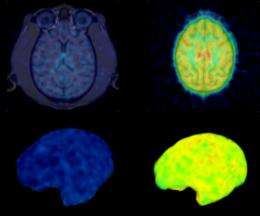Popular flu medication's neurologic side effects in children studied

Oseltamivir is the weapon of choice for preventing influenza infection from taking hold, but like any other drug, it also has the potential for adverse effects. Children in particular are susceptible to neurological symptoms, including delirium and an increased tendency for self-injury.
In partnership with University of Tokyo researcher Yuichi Sugiyama, a team led by Hirotaka Onoe at the RIKEN Center for Molecular Imaging Science, Kobe, recently discovered how age might influence the effects of oseltamivir1. “We speculated that changes in drug transporter function may influence the penetration of oseltamivir and its effects in the brain,” says Onoe.
The capillaries that oxygenate the brain are tightly sealed to prevent potentially toxic compounds or pathogens in the blood from penetrating the central nervous system. Specialized transporter proteins that pump toxic compounds out of the brain bolster the effectiveness of this ‘blood–brain barrier’.
Oseltamivir and verapamil, a drug for cardiac arrhythmia, are believed to be exported by the P-glycoprotein (P-gp) transporter protein. Onoe and colleagues therefore tracked the circulation of radioactively labeled drugs in infant, adolescent and adult rhesus macaques to monitor whether or not P-gp function changes as monkeys age.
Strikingly, both drugs achieved considerably greater penetration into the brain in younger animals. For example, the maximum concentration of oseltamivir within the brain was 3.7-fold higher in infants than adults, and 2.7-fold higher in adolescents relative to their elder counterparts.
Similar results were observed with verapamil (Fig. 1). Some of this disparity could be accounted for by increased overall drug levels in the bodies of younger animals, possibly due to less efficient metabolic processing. However, even when this effect was accounted for, the researchers found clear evidence that older animals purge verapamil from the brain faster than infants and adolescents.
These results are in keeping with previous studies in rodents, which have indicated that P-gp levels increase as animals get older. “The most interesting finding from this study is the significant difference in P-glycoprotein function observed among nonhuman primates of different ages,” says Onoe.
The extent to which the physiology of drug clearance in nonhuman primates mirrors that of humans remains the subject of debate. Nevertheless, these findings suggest a mechanism by which oseltamivir and other drugs could provoke adverse neurological effects in younger patients. Onoe and colleagues hope to further pursue their hypothesis. “We’d like to try clinical studies to assess the evidence found in this study, and understand the ontogeny of drug transporter function in humans,” he says.
More information: Takashima, T., et al. Developmental changes in P-glycoprotein function in the blood–brain barrier of nonhuman primates: PET study with R-11C-verapamil and 11C-oseltamivir. Journal of Nuclear Medicine 52, 950–957 (2011).
















